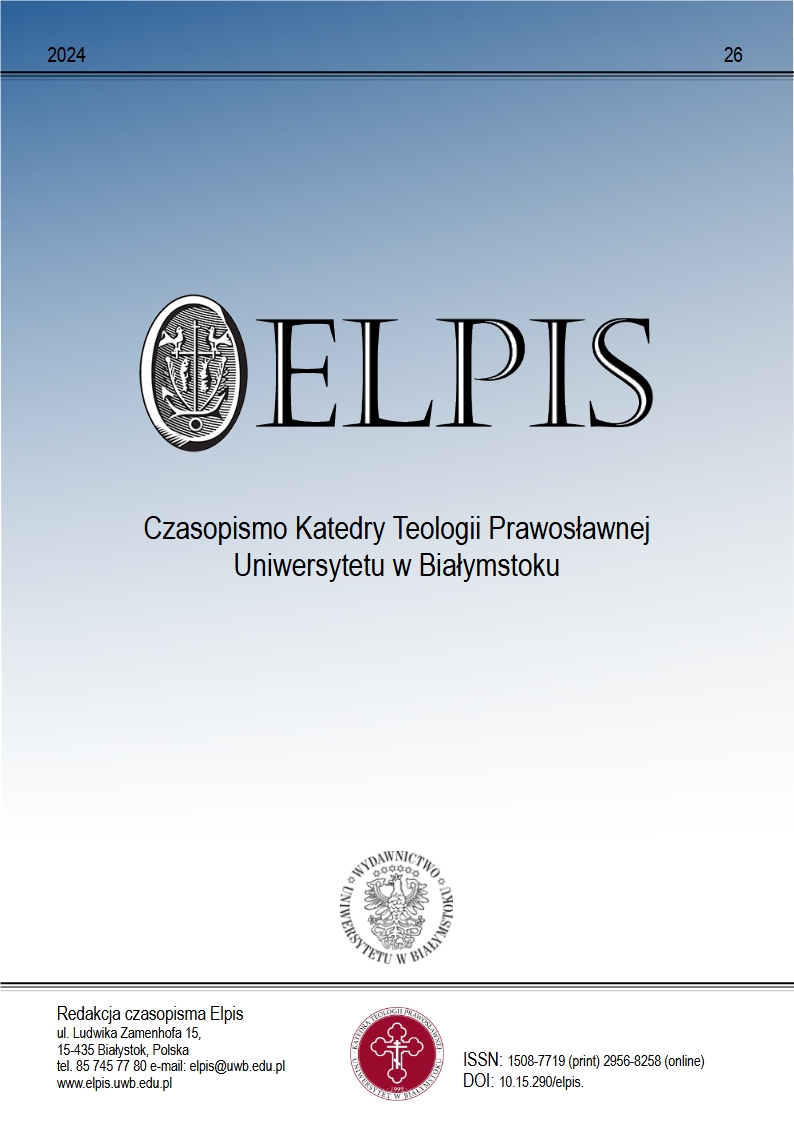Reception of the Gospel readings in the hymnography of Holy Monday in the Jerusalem rite
DOI:
https://doi.org/10.15290/elpis.2024.26.06Keywords:
hymnography, Holy Week, Jerusalem rite, Gospel readingsAbstract
This article focuses on the reception of the Gospel readings of Holy Monday in the liturgical hymnography of that day. In the paper, the liturgical readings and hymnography of the Jerusalem rite, which is one of the oldest rites of the Eastern liturgical tradition, were analyzed. The author used sources such as the Jerusalem Lectionary, the Iadgari and the Typikon of the Anastasis. The research aimed to determine how often the authors of the Holy Monday liturgical hymns were inspired by passages from the Gospel, and what was the reception of this book in their works. After the analysis, it was determined that the primary source used by the hymnographers was the Gospel, especially the liturgical readings of Holy Monday.
Downloads
References
Arranz, M. (1979). Kak molilisʹ Bogu drevnie vizantiĭcy. Sutočnyĭ krug bogosluženiâ po drevnim spiskam vizantiĭskogo Evhologiâ. Leningrad: Leningradskaâ Duhovnaâ Akademiâ.
Egeria. (2018). The Pilgrimage of Egeria: A New Translation of the Itinerarium Egeriae with Introduction and Commentary, tłum. wstęp i kom. A. McGowan, P. F. Bradshaw. Collegville, Minnesota: Liturgical Press Academic.
Galadza, D. (2018). Liturgy and Byzantinization in Jerusalem. Oxford: Oxford University Press.
Galadza, D. (2021). Svâtogrobskyj Tipikon. Pravoslavnaâ Èncilkopediâ 62 (s. 141–144). Moskva.
Hevsuriani, L. (2014). Iadgari. Pravoslavnaâ Èncilkopediâ 20 (s. 419-424). Moskva.
św. Jan Chryzostom, Homilia 65 na Ewangelię wg św. Mateusza, PG 58, 618-626.
Kekelidze, K. (1912). Ierusalimskij kanonarʹ VII veka gruzinskaâ versiâ. Tiflis.
Ławreszuk, M. (2014). Modlitwa wspólnoty: historyczny rozwój prawosławnej tradycji liturgicznej. Białystok: Wydawnictwo Uniwersytetu w Białymstoku.
Menaion Augustou. (1852). Wenetia.
św. Nikodem Hagioryta. (1836). Eortodromion. Wenetia: Tipografia Nikolaou Gliki.
Papadopoulos-Kerameus, A. (1894). Analekta Jerosolimitikis Stachiolojias: T. 2. Petroupoli: B. Kirsbaoum.
Przyczyna, W., Czarnecka, K., Ławreszuk, M. (red.). (2022). Słownik polskiej terminologii prawosławnej. Białystok: Wydawnictwo Uniwersytetu w Białymstoku.
Renoux, C. (2008). L'hymnaire de Saint-Sabas (Ve-VIIIe siècle): le manuscrit Géorgien H 2123. Turnhout: Brepols.
Taft, R. (1992). The Byzantine Rite. A Short History. Collegeville, Minnesota: Liturgical Press.
Tarchnischvili M. (1959), Le grand lectionnaire de l’Église de Jérusalem (Ve–VIIIe): T. 1. Louvain: Secrétariat du CorpusSCO.
Tarchnischvili M. (1960), Le grand lectionnaire de l’Église de Jérusalem (Ve–VIIIe): T. 2. Louvain: Secrétariat du CorpusSCO.
Triodion Kataniktikon. (1856). Tipografeio tou Agiou Georgiou.
Downloads
Published
How to Cite
Issue
Section
License
Copyright (c) 2024 Piotr Sterlingow

This work is licensed under a Creative Commons Attribution-ShareAlike 4.0 International License.
The detailed terms of the CC BY-SA license (Attribution - Share Alike) are available on the Creative Commons website - link.
The author must complete and send to the editorial office (elpis@uwb.edu.pl) the completed and signed author's contract with a declaration of the originality of the article and the author's contribution to the article. Download Agreement File: HERE








